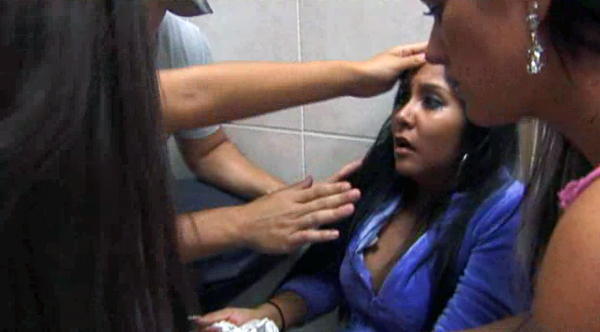These are certainly turbulent times we live in. Societal rules and regulations change from day to day, with neither side of the spectrum (whether it be gender, socioeconomic, political, etc.) completely happy. We need a display of freakery for an acceptable medium to mock, show disdain for, and possibly even envy, the subject of the display. I am reminded of the Coney Island Circus Sideshow, the "last place in the USA where you can experience the thrill of a traditional ten-in-one circus sideshow" (www.coneyisland.com).
The show that we experienced was a mix of social and corporeal freakery. There were performers like Donnie Vomit, "the human blockhead," who drilled a 4-inch bit up hit nose and walked on glass; and his co-showmaster Heather Holliday, who was a contortionist and a sword swallower. Bethany even had the opportunity to pull a 3-foot twisted blade out of Heather's gut. At the same time, there were performers who would, today, be called disabled, but took full enjoyment in being "freaks." One performer suffered from Phocomelia, or "flipper-like limbs," which he explained to be a side-effect of his mother's taking Thalidomide while pregnant with him; he is a fabulous percussionist, and began his bit by performing the entire dance to Michael Jackson's "Thriller."The other corporeal freakish performer had fingers and toes that were fused into three digits on each extremity. He spoke with a Southern accent, juggled as well as any other person I'd ever seen, and referred to his corporeal differences as "super happy hands and feet." One might say that he was, in essence, mocking himself. I really think that he was happy with the life.
Donnie Vomit. Photos courtsey of http://www.coneyisland.com/per.donny.shtml
Heather Holliday. Photo courtesy of http://www.coneyisland.com/per.heather.shtml
Bethany and I left the sideshow, we were two people "Bound together by their purchased assurance that they are not freaks" and found that we even "longed in some sense to be extraordinary marvels instead of mundane, even banal democrats..." (Thomson, 10). We were both jealous of the beautiful Heather Holliday and the exceedingly charismatic Donnie Vomit. Though Bethany has a good job and a wide skill set, and I am nearly a college graduate going into a field that I love, we still find ourselves wanting to "go join the circus" from time to time. No matter how amazing I found the other's talents, though, I was never envious of the man with flipper-like limbs or his friend with claw-like hands and feet. What does that say?
There are boundaries on the allowances for envying "freaks." I can want to be like someone with talents, but not like someone whose talents are based off of their disabilities. It is alright to envy a "freak of culture" (Thomson, 10), rather than a corporeal freak. When looking at the situation from this angle and that of comparison, I began to understand the popular obsession with shows like MTV's Jersey Shore. Like the freak show, the pervasive popularity of such reality TV shows "fashioned...the American cultural self" (Thomson, 10).
Like freak show performers, the subjects of Jersey Shore have "conventionalized stage names," and show is entirely about their corporeal and societal differences. They sport names like Snooki and The Situation, tan themselves and work out until they are obviously unlike the people who they choose to subject as "others." The funny thing to me, though, is that the average person thinks that Jersey Shore is "a serious freak show. It's one hot mess after another. I love it!" (Scotto). In the same conversation, my cousin told me that she watches that show, and others on MTV, because it helps her get away from real life, but also helps her realize that "no matter how messed up things get, at least I'm not that bad" (Scotto).
Snooki, in her typical season 1 shot (being tended after getting hit in the face at a bar)
Photo courtesy of http://www.thehollywoodgossip.com/gallery/tending-to-snooki/
In the end, I believe it's true that all forms of freakery exist "for commercial ends" (Thomson, 7) and that they are used as a comparison for normalcy. We all need the occasional reiteration of the fact that we are, in fact, just like everyone else. "Freakifying" people who are different than we is a way of reaching this understanding. Really, though...we're all just freaks of a different color.
Works Cited:
Thomson, Rosmarie Garland. "Introduction: From Wonder to Error--A Genealogy of Freak Discourse in Modernity." Freakery: Cultural Spectacles of the Extraordinary Body. Ed. Rosemarie Garland Thomson. New York: NYU Press, 1996.



No comments:
Post a Comment
Note: Only a member of this blog may post a comment.